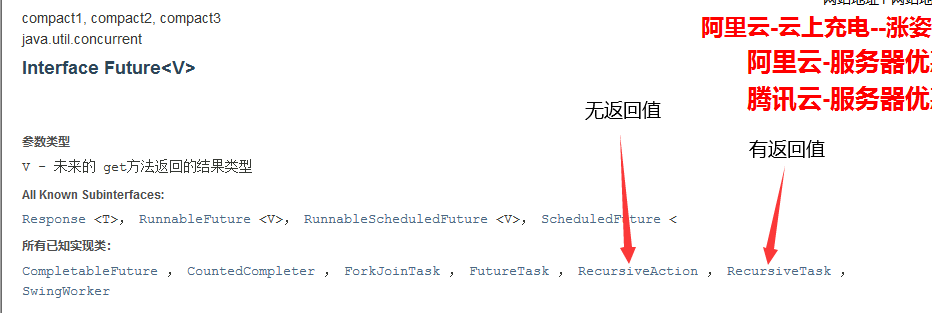Lambda - 流式 - 分治
函数式接口
新时代的程序员:lambda表达式、链式编程、函数式接口、Stream流式计算
函数式接口:只有一个方法的接口 ——> Runnable / Callable
@FunctionalInterface
public interface Runnable {
public abstract void run();
}
//新版java中有很多很多FunctionalInterface
//简化编程模型,再新版本的框架底层大量应用
//forEach(消费者类的函数式接口)
2
3
4
5
6
7
8
Function 函数型接口
@FunctionalInterface
public interface Function<T, R> {
/**
* Applies this function to the given argument.
*
* @param t the function argument
* @return the function result
*/
R apply(T t);
}
2
3
4
5
6
7
8
9
10
11
有一个传入参数,有一个返回值(均为泛型,默认Object),仅含一个方法:apply (Object o, Object b)
import java.util.function.Function;
public class FunctionTest {
public static void main(String[] args) {
/**用匿名内部类重写apply函数
* Function<String, String> f = new Function<String, String>() {
* @Override
* public String apply(String str) {
* return str;
* }
* };
*/
//用lambda表达式简化
Function<String, String> function = (str)->{return str;};
System.out.println(function.apply("daslkfj"));
}
}
2
3
4
5
6
7
8
9
10
11
12
13
14
15
16
17
Predicate 断定型接口
@FunctionalInterface
public interface Predicate<T> {
/**
* Evaluates this predicate on the given argument.
*
* @param t the input argument
* @return {@code true} if the input argument matches the predicate,
* otherwise {@code false}
*/
boolean test(T t);
}
2
3
4
5
6
7
8
9
10
11
12
传入一个参数(默认Object),返回一个布尔值,所含方法为 test
import java.util.function.Predicate;
public class PredicateTest {
public static void main(String[] args) {
/**
* Predicate p = new Predicate() {
* @Override
* public boolean test(Object o) {
* return o.toString().isEmpty();
* }
* };
*/
Predicate<String> predicate = (str)->{return str.isEmpty();};
System.out.println(predicate.test("alksd"));
}
}
2
3
4
5
6
7
8
9
10
11
12
13
14
15
16
17
Consumer 消费型接口
@FunctionalInterface
public interface Consumer<T> {
/**
* Performs this operation on the given argument.
*
* @param t the input argument
*/
void accept(T t);
}
2
3
4
5
6
7
8
9
10
消费者只有输入,没有返回值(消费)
import java.util.function.Consumer;
public class ConsumerTest {
public static void main(String[] args) {
Consumer<String> consumer = (str) -> {System.out.println(str);};
consumer.accept("daskfj");
}
}
2
3
4
5
6
7
8
Supplier 供给型接口
@FunctionalInterface
public interface Supplier<T> {
/**
* Gets a result.
*
* @return a result
*/
T get();
}
2
3
4
5
6
7
8
9
10
供给者没有输入,只有返回值(供给)
import java.util.concurrent.*;
import java.util.function.Supplier;
public class SupplierTest {
public static void main(String[] args) {
Supplier<String> supplier = ()->{return Thread.currentThread().getName();};
ExecutorService executorService = new ThreadPoolExecutor(
3,
12,
5,
TimeUnit.SECONDS,
new ArrayBlockingQueue(9),
Executors.defaultThreadFactory(),
new ThreadPoolExecutor.AbortPolicy()
);
for (int i = 0; i < 12; i++) {
executorService.execute(()->{
System.out.println(supplier.get());
});
}
executorService.shutdown();
}
}
2
3
4
5
6
7
8
9
10
11
12
13
14
15
16
17
18
19
20
21
22
23
Stream流式计算
什么是Stream流式计算
大数据:存储+计算
存储:集合框架、MySQL(本质就是存储东西的)
计算:流(计算都交给流来操作)
- 已知有Person类,用一行代码完成下列筛选操作
- 1、ID为偶数
- 2、年龄大于等于23
- 3、名字转换为大写字母
- 4、倒序输出
- 5、只输出一个用户
Person类:
public class Person {
private int id;
private String name;
private int age;
public Person(int id, String name, int age) {
this.id = id;
this.name = name;
this.age = age;
}
public int getId() {
return id;
}
public String getName() {
return name;
}
public int getAge() {
return age;
}
}
2
3
4
5
6
7
8
9
10
11
12
13
14
15
16
17
18
19
20
21
22
23
lambda表达式+链式编程+函数式接口+stream计算:
public class StreamTest {
public static void main(String[] args) {
Person p1 = new Person(1, "a", 23);
Person p2 = new Person(2, "b", 27);
Person p3 = new Person(3, "c", 17);
Person p4 = new Person(4, "d", 41);
Person p5 = new Person(5, "e", 25);
List<Person> list = Arrays.asList(p1, p2, p3, p4, p5);
list.stream()
.filter((u)-> {return u.getAge()>=23;})
.filter((u)-> {return u.getId()%2==0;})
.map((u)-> {return u.getName().toUpperCase();})
.sorted((u1, u2)->{return u2.compareTo(u1);})
.limit(1)
.forEach((u)->{System.out.println(u);});
}
}
2
3
4
5
6
7
8
9
10
11
12
13
14
15
16
17
18
异步回调
Fork / Join
分支 / 合并
再jdk1.7中出现,并发执行任务,在大数据量时提高效率
大数据:Map Reduce(把大任务拆分为小任务,再把小任务结果合并 ——> 递归)
ForkJoin特点:工作窃取
维护的都是双端队列,当 B 线程结束后而 A 线程未结束,B 将窃取 A 的工作,从后向前执行
具体实现:
1、将运算类继承 RecursiveAction 或 RecursiveTask,重写 computer 方法(注意泛型:此处泛型类型规定了 compute 方法的返回值)
import java.util.concurrent.RecursiveTask;
public class ForkJoinTest extends RecursiveTask<Long> {
private long start;
private long end;
private long temp = 10000L;
public ForkJoinTest(long start, long end) {
this.start = start;
this.end = end;
}
//重写computer
@Override
protected Long compute() {
if(end-start<temp){
long sum = 0L;
for (long i = start; i <= end; i++) {
sum += i;
}
return sum;
}else{
long middle = (start+end)/2;
ForkJoinTest task1 = new ForkJoinTest(start, middle);
task1.fork();
ForkJoinTest task2 = new ForkJoinTest(middle+1, end);
task2.fork();
return task1.join()+task2.join();
}
}
}
2
3
4
5
6
7
8
9
10
11
12
13
14
15
16
17
18
19
20
21
22
23
24
25
26
27
28
29
30
31
32
33
2、开辟一个 ForkJoinPool,用池中的 submit 方法或 execute 方法执行 Task
public void test2() throws ExecutionException, InterruptedException {
long start = System.currentTimeMillis();
//创建ForkJoin池
ForkJoinPool pool = new ForkJoinPool();
//创建任务
ForkJoinTask<Long> task = new ForkJoinTest(0, 10_0000_0000);
//此处 submit.get() 和 execute(task) 后的 task.get() 所得其实是一样的
//执行任务
ForkJoinTask<Long> submit = pool.submit(task);
pool.execute(task);
submit.get();
long end = System.currentTimeMillis();
//关闭池
pool.shutdown();
//获取结果
System.out.println("和:" + task.get() + " 时间:" + (end-start));
}
2
3
4
5
6
7
8
9
10
11
12
13
14
15
16
17
18
19
20
21
22
如此大大提高了运算效率,比用普通的 for 循环逐个加约快 130 倍
阅读源码还可知 ForkJoinPool.execute() 还可以执行 Runnable task,即实现了 Runnable 接口的任务,重写 run 方法,同理还可以扩展至 Callable 接口,通过 FutureTask 将 Callable 和 Runnable 连接,放在 execute 中执行
public void execute(Runnable task) {
if (task == null)
throw new NullPointerException();
ForkJoinTask<?> job;
if (task instanceof ForkJoinTask<?>) // avoid re-wrap
job = (ForkJoinTask<?>) task;
else
job = new ForkJoinTask.RunnableExecuteAction(task);
externalPush(job);
}
2
3
4
5
6
7
8
9
10
流式求和:
public void test3(){
long start = System.currentTimeMillis();
long sum = LongStream.rangeClosed(0, 10_0000_0000).parallel().reduce(0, Long::sum);
long end = System.currentTimeMillis();
System.out.println("和:" + sum + " 时间:" + (end-start));
}
2
3
4
5
6
Future 异步回调
Future设计的初衷:对将来的某个事件的结果进行建模
异步和同步的区别,类似普通方法和同步方法的区别

继承关系:Future ——> CompletableFuture
import java.util.concurrent.CompletableFuture;
import java.util.concurrent.ExecutionException;
import java.util.concurrent.Future;
public class Demo01 {
public static void main(String[] args) throws ExecutionException, InterruptedException {
//无返回值的异步回调:runAsync
/*CompletableFuture<Void> completableFuture = CompletableFuture.runAsync(()->{
System.out.println("异步回调");
});
System.out.println("111111111");
completableFuture.get();*/
//有返回值的异步回调:supplyAsync
CompletableFuture<String> completableFuture = CompletableFuture.supplyAsync(()->{
System.out.println("哈哈哈");
//int i = 9/0;
return "异步回调";
});
// t:当正确执行时返回返回值,报错时返回null
// u:当错误时返回错误信息,正确时返回null
//exceptionally(e):e为异常,注意需要在该函数接口中重新返回一个值代替错误执行的返回值
System.out.println(completableFuture.whenComplete((t, u) -> {
System.out.println("t:" + t);
System.out.println("u:" + u);
}).exceptionally((e) -> {
System.out.println("Message:" + e.getMessage());
return "错误了啊";
}).get());
}
}
2
3
4
5
6
7
8
9
10
11
12
13
14
15
16
17
18
19
20
21
22
23
24
25
26
27
28
29
30
31
32
33
为什么代码这么奇怪?supplyAsync 和 runAsync 是 CompletableFuture 的静态方法,返回一个 CompletableFuture 对象
常用方法:
| 方法 | supplyAsync | runAsync |
|---|---|---|
| get | 执行supplier并获取返回值 | 执行runnable |
| exceptionally | 捕捉异常并返回错误回调 | 捕捉异常并作出反应 |
| whenComplete | 返回(T, U),T为返回值,U为错误信息 | 返回(T, U),T为null,U为错误信息 |
- 注意 get / exceptionally / whenComplete 方法阻塞但异步,不影响其他线程
异步回调:
1、成功回调
当 CompletableFuture 正常跑 runAsync 或 supplyAsync 后,成功返回结果,称作成功回调
2、错误回调
当跑 runAsync 或 supplyAsync 时发生错误,我们用 exceptionally 捕捉异常并作出反应,在 supplyAsync 中可返回错误回调

